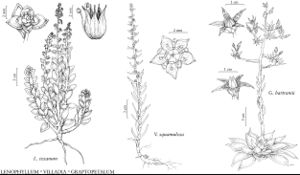Villadia
in N. L. Britton and J. N. Rose, New N. Amer. Crassul., 3. 1903 ,.
Herbs [subshrubs], perennial, (dying to near base [or not], new shoots forming dense rosettes often by anthesis), not viviparous, 0.5–2.5 dm, glabrous [pubescent]. Stems decumbent-ascending [erect], branching [or not], herbaceous [± woody]. Leaves persistent, basal and cauline, alternate, ± alike, gradually smaller, sessile, not connate basally; blade linear, subterete, 1–2.5 cm, fleshy, base spurred, margins entire; veins not conspicuous. Inflorescences terminal spikes or narrow thyrses. Pedicels: flowers subsessile. Flowers erect, 5-merous; sepals distinct, all alike; petals spreading from middle [erect], connate basally, nearly distinct, rose; calyx and corolla not circumscissile in fruit; nectaries cuneate; stamens 2 times as many as sepals; filaments adnate to corolla base; pistils erect, nearly distinct; ovary base truncate; styles 2+ times shorter than ovary. Fruits erect. Seeds obovoid, with papillose ribs. x = 9–17, 20–22, 33+.
Distribution
Tex., Mexico, Central America (Guatemala), South America (Peru)
Discussion
Species ca. 25 (1 in the flora).
The status of Villadia is debatable. The former sect. Altamiranoa (Rose) R. T. Clausen, which clearly intergrades with Mexican Sedum and differs chiefly in its connate petals, seems better placed in Sedum (C. H. Uhl and R. V. Moran 1999). Villadia proper is weakly distinguished from the huge and multifarious genus Sedum, now treated by H. ’t Hart (1995) as paraphyletic, but it seems a taxonomic convenience to remove such peripheral groups as this (Moran 1990). Uhl (1963, 1992) has found that Altamiranoa and Villadia belong to the same huge comparium as Echeveria, Graptopetalum, Lenophyllum, and others. Villadia is like Echeveria in having a remarkably long, descending series of evidently diploid chromosome numbers, namely 21, 20, and 17 to 9, as well as a few higher, polyploid numbers (Uhl and Moran). R. C. H. J. van Ham and ’t Hart (1998) found that Villadia is closely related to least advanced Eurasian Sedum and the Mexican genera Echeveria and Pachyphytum.
Villadia misera (Lindley) R. T. Clausen is reported from Arizona under the synonym V. parviflora (Hemsley) Rose; R. T. Clausen (1940), without comment, cited a collection by W. B. Cannon and F. E. Lloyd (NY [also US]), supposedly from the San Francisco Mountains. There is no other record for Arizona, and the nearest undoubted locality is in Zacatecas, some 1500 km to the southeast. These are cultivated specimens, and the label locality evidently is wrong.
Selected References
None.
